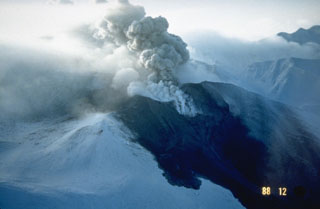Report on Tokachidake (Japan) — July 1985
Scientific Event Alert Network Bulletin, vol. 10, no. 7 (July 1985)
Managing Editor: Lindsay McClelland.
Tokachidake (Japan) Two new vents eject hot water, burning sulfur
Please cite this report as:
Global Volcanism Program, 1985. Report on Tokachidake (Japan) (McClelland, L., ed.). Scientific Event Alert Network Bulletin, 10:7. Smithsonian Institution. https://doi.org/10.5479/si.GVP.SEAN198507-285050
Tokachidake
Japan
43.418°N, 142.686°E; summit elev. 2077 m
All times are local (unless otherwise noted)
Thermal activity that formed new vents [on the wall of] the 1962 crater began in late May and continued through July. Beginning on 29 May and ending 5 June, hot muddy water was ejected from a new 10-m-diameter oval vent in the wall of a summit crater formed in 1962. Weak ash emission occurred nearby on 19 June, forming a second new vent, also oval and about 15 m in diameter, on 20 June. Molten sulfur burned in and around the new vents and weak red glow was observed over the 1962 crater from the town of Biei, 7 km away, on the nights of 20-22 June.
The second hot muddy water ejection began on 24 June. JMA personnel from the Tokachidake Observatory visited the crater on 9 July and found that this activity had stopped. On 25 July, a third ejection began at the June vent and continued through 31 July. The maximum height of white plumes from the two new craters was 80 m [in July]. Seismicity remained low in June and early July, as in previous months. Thermal activity at the 1962 crater has been gradually increasing since 1983.
Geological Summary. Tokachidake volcano consists of a group of dominantly andesitic stratovolcanoes and lava domes arranged on a NE-SW line above a plateau of welded Pleistocene tuffs in central Hokkaido. Numerous explosion craters and cinder cones are located on the upper flanks of the small stratovolcanoes, with the youngest Holocene centers located at the NW end of the chain. Frequent historical eruptions, consisting mostly of mild-to-moderate phreatic explosions, have been recorded since the mid-19th century. Two larger eruptions occurred in 1926 and 1962. Partial cone collapse of the western flank during the 1926 eruption produced a disastrous debris avalanche and mudflow.
Information Contacts: JMA, Tokyo.

